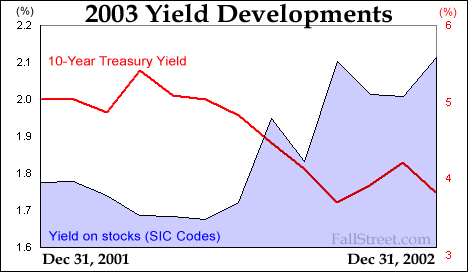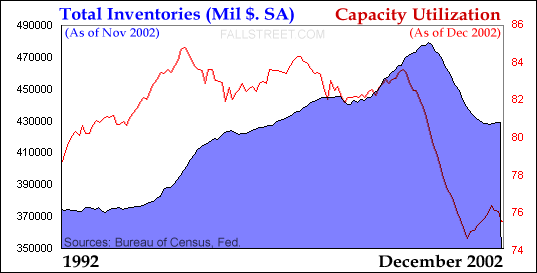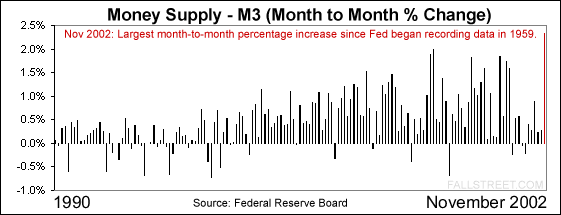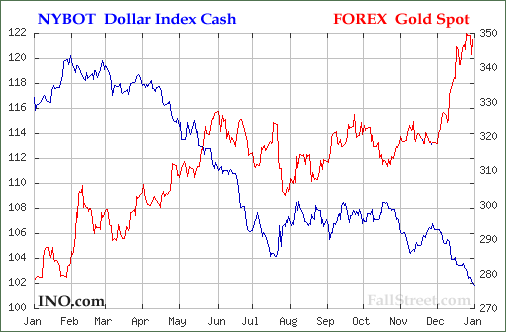Preview of 2003: Pawns in the Game?
By Brady Willett & Todd Alway
“Investors that own any stocks outside of select areas (gold/silver, hard assets with dividends) should be prepared for their portfolio to take a hit.” Preview 2002
It is worth reiterating our 2002 sentiments at this time, not only to confirm our bearish position, but to bring into focus our ‘bullish’ observations. Quite frankly, we still believe that the excesses created in the 1990s (excess industrial capacity, excess consumer and corporate debt, and excessive valuations in the marketplace), warrant a selective portfolio of stocks along with an ample amount of liquidity. By ‘liquidity’ we mean to say that the investor, as was the case in 2002, should be prepared for better investment opportunities by holding cash.
However, as the great bear market continues to beat stock prices lower, as valuations retreat, and as investor expectations get reduced, opportunity nears…
Part I: The Pre-Emptive Investment Portfolio
Iraq has allowed weapons inspectors back in. No one believes that Iraq currently has the capability to produce nuclear weapons, yet the United States wants to attack. By contrast, North Korea has kicked weapons inspectors out and has an acknowledged capacity for manufacturing nuclear arms. However, in this case the U.S. is seeking a diplomatic resolution. For some, making sense of what seems to be contradictory U.S. foreign policy boils down to oil – Iraq has it while North Korea does not. However, what is likely closer to the truth is that since North Korea already has nuclear capabilities, while Iraq does not, the U.S. has been forced into seeking a diplomatic solution with the Pyongyang regime. After all, if Iraq did have nuclear capabilities there would not be 80,000+ U.S. troops amassing around the Iraqi border…within firing range of current Iraqi ballistic weapons.
How the Iraq/North Korea conundrums play out will obviously have an impact on the global financial markets. Likewise, the manner in which the Israeli/Palestinian situation progresses will in part determine the overall geopolitical climate in the Middle East. Attempting to invest based upon the potential outcomes of these and other geopolitical flash points is not a desirable pursuit – the very thought of attempting to profit from bloodshed is repugnant. However, the investor cannot help but be aware of the geopolitical situation as it relates to potential warfare, potential defaults (Brazil), or potential economic crises (Japan). To be sure, the investor, for lack of a better term, is a pawn that needs to be positioned correctly if it is to weather the storm.
Challenges of The Empire
To begin with, whether or not U.S. foreign policy is successful hinges, in large part, upon its ability to convince the public that its intentions are noble. Perception is key: Does the U.S. offer unwavering support for Israel because the Israeli people are victims of terrorism, or is the U.S. implicitly supporting the colonization of Palestine by providing Israel with vast sums of foreign aid? Does the U.S. want to oust Saddam Hussein because he is a madman that poses a potential threat to the U.S., or is it because he controls the second largest oil reserves in the world?
As the U.S. attempts to assure the world that its foreign policy serves the general interest, many questions lurk, questions driven by what appears to some as basic hypocrisy. In the case of nuclear capability, for example, the U.S. focus on non-proliferation rather than disarmament can quite naturally lead to allegations of racial or civilizational bias. On what grounds can it be justified for the U.S., Britain, France, Russia, and Israel to produce nuclear weapons while concurrently condemning as “rogue states” those like Iraq and North Korea who attempt to acquire them for themselves? The moral high ground in such cases is less than clear. Is it any wonder, therefore, that the U.S. justification for launching a conflict against Iraq is construed in the region as an assault on Islam rather than an attempt to protect the world from weapons of mass destruction?
As new flash-points (North Korea) have heated up, Congressman Ron Paul has asked a question that many have been entertaining: “Does this mean we will stretch our military forces even thinner, to fight three or five or ten conflicts, if necessary to play world policeman in the new American empire?”
Leading into 2003 and beyond, the “Empire’s” foreign policy provides much of the uncertainty for the U.S. and global financial markets. Regardless of the ultimate moral correctness of these policies, one does need to understand that the challenges the American Empire faces are unlikely to go away.
The Preemptive Portfolio
What the current geopolitical situation highlights is the fact that investors need patience. As Buffett says, ‘look to buy when others are fearful….’ Every investor knows that the world is mindful of geopolitical tensions, but perhaps not yet fearful.
Should current geopolitical tensions escalate into actual military engagement, those investors that are not fully invested in overvalued U.S. equities will fair better than those that are. Moreover, while comparisons to the Gulf-War and 9/11 abound – the U.S. markets always rebound to higher levels soon after war! – the fact remains that following crisis-like developments the markets always drop first. This is not so much a doomsayer scenario aimed at evoking fear, but the realization that the American Empire is preparing for war. The investor should not, therefore, be surprised when battles ensue.
Part II - Checkmate against the Fed?
In 2002, every single S&P sector dropped for the first time since the statistics began being recorded. Moreover, record personal and corporate bankruptcies were logged, the markets dropped for the third year in a row, gold rallied by more than 20%, and the U.S. dollar ended the year at its lows. For most, these occurrences are summed up with one word – ugly – but for those investors who were prepared, 2002 could not have been more beautiful.
As Abby Joseph Cohen stated in December 2002, ‘By many measures, 2002 was a surprisingly good year.’ For once we are in agreement with Abby; the average investor should consider themselves extremely lucky that the slide in stocks during October 2002 did not turn into a complete meltdown. Furthermore, the average investor should be thankful that, thanks to slumping bond yields, stocks are more attractive today than when 2002 began.
 |
As the above chart highlights, during 2002 the average dividend yield on stocks rose while Treasury yields declined. This trend, especially should it persist, makes stocks more attractive.
However, while dividend yields have become plumper, or more attractive compared to bonds, other valuation matrixes have yet to fall to attractive levels. To be sure, the Dow 30 currently trades at more than 20 times trailing earnings and has an average PEG ratio of 2.07, or double what is typically considered attractive. Furthermore, earnings estimates on the Dow, which currently stand at an expected 11.2% increase over each of the next 5-years, require more than triple the performance of the last 5-years (+3.45%). To note: the above estimates (for most stocks) do not take into account stock option compensation, underfunded pension funds, or the potential shortfalls that may be encountered should the SEC and FASB ever get around to consolidating off balance sheet financing activities (i.e. SPEs). Nevertheless, Wall Street’s earnings estimates (and regardless of whether or not you focus on ‘operational’, ‘as reported’, or other ‘core’ variants), are pricing in not only a sustainable earnings recovery, but a powerful earnings rebound. As 2002 aptly demonstrated, earnings estimates are regularly not only incorrect, but dramatically overestimated.
|
||||||||||||||||||||||||||||||
With these things in mind, and while we agree with Gabby that 2002 was a ‘good year’ for the prepared investor, it certainly was not a good year for Cohen or any other analyst banking on escalating valuations and increased investor euphoria. Abby was calling for Dow 11,300 for most of 2002, and lowered her target in October to 10,800. Indeed, not much went right for the lady that once called Enron a ‘good value’ moments before it went under…
Quality & Sustainability of Economic Growth
The U.S. managed to eek out growth in 2002. However, the headline GDP growth number, which is government procured and subject to revisions in the future, does not fully describe the state of the U.S. economy coming out of 2002. In fact, the predominant economic trends heading into the new year are rising unemployment and slowdown. These are hardly auspicious trends for a recovery in profit levels.
The challenges the U.S. economy faces are well documented; the consumer’s penchant for debt may (has) dwindle(d), government deficits are unsustainable, trade deficits are unsustainable, real estate assets cannot infinitely be leveraged, and unemployment is, albeit at a slower pace than when 2002 began, rising.
While each of these items deserves consideration, none outweighs the realization that the pricing environment in the U.S., referring to the ability of companies to increase prices/profits, is in shambles. One need only consider the current capacity/inventory situation: capacity utilization remains at depressed levels while inventory levels have stabilized. The point is that even if increased demand does put pressure on inventories, the capacity figures suggest that most businesses could crank out more production without hiring new workers or purchasing new machinery.
 |
As Leon Levy noted in the December 9 issue of Forbes, “Nothing is in short supply… autos, fiber-optic cable, computers, cell phones, trucks, airplanes, steel, even food…If nothing is in short supply, how can profits rise?”
Beyond Mr. Levy’s and Mr. Greenspan’s ‘deflationary’ concerns, it is also worth noting that companies that are raising prices are not necessarily seeing a corresponding rise in profits. Rather, as commodity prices have rallied strongly in 2002 many companies have raised prices simply to maintain rates of profitability. Such a situation has the potential to reduce consumer purchasing power and ultimately demand. In sum, a rise in commodity prices, especially since the rise has not been to meet pent up demand but to cope with production issues, can be a negative for both consumers and corporations.
Fed Eyes Deflation
With commodity prices rising and economic growth weak, the logical conclusion would seem to be that a period of ‘stagflation’ is developing. However, unlike the 1970s, the period for which the term ‘stagflation’ was coined, the Fed is not seeking to stymie inflationary pressures, but to ensure that deflation does not take hold. In the process, there has been a change in tactic: Following an aggressive 50 point rate reduction in November, Greenspan and company have switched their focus from interest rates to the money supply. Since interest rates have lost their effectiveness, another tool must be used to try and influence the rate of rate of inflation.
 |
That the Fed is now focusing on aggressively increasing the money supply warrants attention heading into 2003, because there is considerable doubt whether or not this strategic gambit will position the U.S. economy in a stronger position or reveal its deficient French pawn formation. Since the U.S. dollar has been falling rapidly as of late, continuing this ‘reverse-Volcker’ policy could lead to further deterioration. To be perfectly blunt, with the Fed having already used up nearly all possible rate reductions, if money supply growth does not help the fledging U.S. economy what can?
To be sure, even though Central banks have the unmitigated power to print paper currency, they do not have the ability to control the market price of this currency.
“If investors should conclude that the only option left to policymakers is to print money in quantities sufficient to create rising prices and perhaps dollar depreciation, the continued search for wealth preservation will lead to further purchases and a higher price of gold.” Gold and Deflation, AEI.org. Jan 2003.
 |
Part III -- Conclusions
During 2002 the stock markets became slightly more attractive. However, we would caution investors from slapping too much lipstick on what is still a pig. To be sure, and contrary to the belief that the current market malaise compares to that of the Great Depression, the excesses of the 1990s bull market have still not been expunged. There are still plenty of excesses on which the Bear market can feed. Historically speaking, great bear markets will not expire until Wall Street turns bearish on stocks, P/E averages dip to single digits, and dividend yields surpass those of bonds.
As it now stands, investors are overly confident that an incredible economic turnaround is at hand, or that a groundswell of capital will soon arrive on the scene to save the day. These ‘investors’ include those who invest on the silly notion that stocks rarely decline for four year in a row, that stocks will rise because money market yields are unattractive, that Bush will repeal the double dividend tax, and/or that managers are likely to turn bearish on bonds (conversely bullish on stocks). We reiterate our distrust with these types of investment approaches for one reason: these are not investment approaches! They are attempts to predict the market’s future by indirect means rather than on the basis of the profitability of corporations themselves. As for those who take the above speculations to heart and throw caution to the wind, they should not be surprised when the tornado arrives (as it did in 2002).
In sum, those that trumpet the markets as ‘undervalued’ still place little importance on valuations. Rather, they are speculating that investors will pay more for each share, not necessarily that companies will earn more. Think about it: If First Call reports that S&P 500 earnings are expected to rise by 10% next year, why should stocks rise by any more than 10%?
In 2003, like 2002, the investors that stand to profit will be those who are prepared. To be prepared the investor needs to select stocks wisely, have patience, liquidity, gold, and a pecking list of equities. The last thing the investor needs is to be is conned by Wall Street and the Fed into believing that stocks are the only alternative for their capital.
All data and information within these pages is thought to be taken from reliable sources but there is no guarantee as such. All opinions expressed on this site are opinions and should not be regarded as investment advice.
Copyright © 2000, 2001, 2002
FallStreet.com